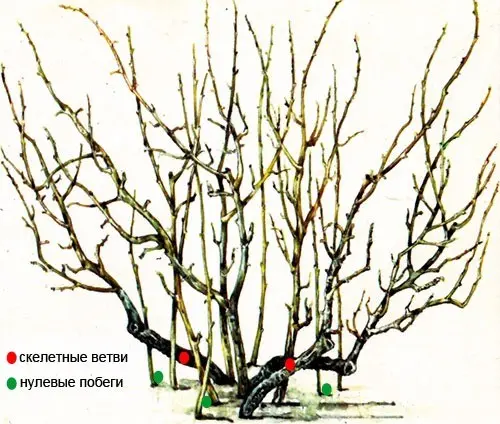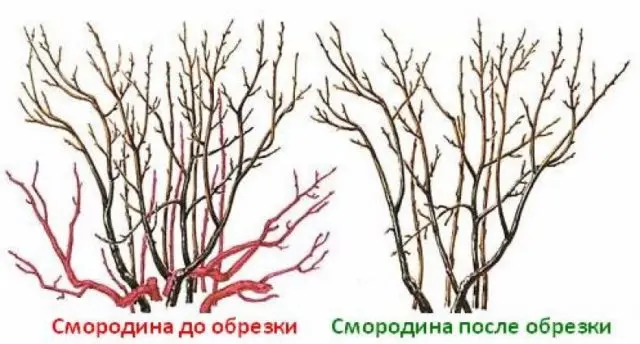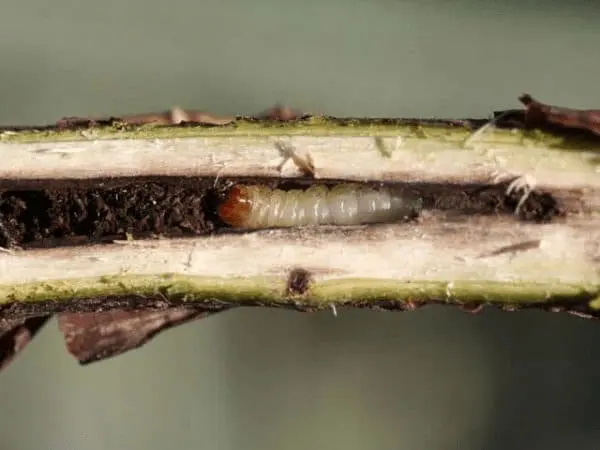Contents
Rejuvenating a blackcurrant bush is not at all difficult if you follow the basic rules for pruning berry bushes. Timely and proper rejuvenation of plantings of this horticultural crop will not only improve their appearance, but also increase productivity.
Why do you need rejuvenation of currant bushes
Sooner or later, every blackcurrant grower is faced with the need to rejuvenate old bushes. With age, the yield of the plant begins to gradually decline, and the quality of the fruit steadily decreases every year.
Rejuvenation will be useful not only for old bushes, but also in cases where the plant has been badly affected by a disease or pest invasion, has a too dense or malformed crown, if its roots are damaged. By removing excess shoots that shade the bush, preventing its ventilation and taking strength from the plant, this procedure will return high yields to blackcurrants, increase immunity to diseases and facilitate planting care.
When to update currant bushes
Shearing blackcurrant is a mandatory event that must be carried out from the first season after planting. The basis of the correct crown of the bush of this culture is a shaping haircut. It is she who in the future greatly facilitates the care of the bush and allows you to easily rejuvenate the old currant that has become old.
Shrub rejuvenation begins at the age of 5–6 years, since this horticultural crop bears fruit on young shoots that have reached the age of 2–3 years. If the bushes are very old, 15 or more years old, their rejuvenation may take several seasons.
You can rejuvenate an old blackcurrant bush in spring or autumn. There is no consensus on which season is best for this. Many experienced gardeners insist that autumn pruning for rejuvenation is preferable, since harvest can be expected as early as next season. Autumn rejuvenation is carried out during leaf fall, before the onset of frost. If juice is released on the cut of the shoot, then the plant is not yet ready for the procedure. The main thing is to finish the haircut before the onset of frost. It will take 2-3 weeks for the cuts to heal. After this time, the currant will be ready for winter.
Blackcurrant rejuvenation in autumn has the following benefits:
- allows you to prepare currants for wintering;
- activates the emergence of new branches;
- involves a longer time interval for the procedure than in the spring;
- stimulates fruiting in the next season.
Spring anti-aging haircut also has its advantages: it can be combined with sanitary pruning, during this period the plant is less susceptible to infection with diseases, it is easier to distinguish affected shoots from healthy ones. The best period for the rejuvenation procedure is from the beginning of the snow melting to the beginning of the growing season. If you cut a bush in the spring, the berries will appear on it only next year, and the plant will spend the current season on restoring green mass.
How to rejuvenate an old currant bush
A rejuvenating haircut is carried out in dry weather so that pathogenic spores contained in rainwater do not fall on fresh cuts. For the procedure you will need: pruner, garden shears and a hacksaw. All tools must be well sharpened so as not to leave broken branches on the branches, further injuring the plant. Before cutting each next bush, the tools must be disinfected, for example, with a solution of potassium permanganate or alcohol. In order to prevent diseases, all plant residues after shearing must be burned.
There are several general rules and principles for rejuvenating a currant bush:
- it is necessary to regulate the growth of new shoots so that approximately the same number of them grows in each season;
- a shoot that gives a weak increase must be cut off, leaving no more than 5 buds. This contributes to the healing and strengthening of the plant;
- the cut should be a few centimeters above the kidney;
- cut the branch at an angle of 45–50 °;
- the number of branches to be cut depends on the strength of the bush. The better it is developed, the more branches it can have. On strong currant specimens, 12–14 shoots are left, 5 are enough for weak ones;
- in order to get a uniform harvest from season to season, it is necessary that there are branches of different ages on the bush;
- long stumps should not be left, as they can serve as a shelter for pests and become a source of infection for all plantings of this horticultural crop;
- slices are recommended to be treated with ash, garden pitch, charcoal or special preparations.
The main goal of bush rejuvenation is to achieve the appearance of new shoots growing from the underground part of the trunk. They are called “zero” shoots. They grow if you cut out a few old viable branches and regularly remove top shoots (thin vertical sprouts that form at the very base) on the remaining skeletal branches. The 3 most developed “zero” branches are left so that fruiting on them is maximum. At the end, the ends of the shoots left for fruiting are shortened to wood.

In addition, when pruning get rid of the following branches:
- broken;
- directed inside the crown;
- lying on the ground;
- yielding no harvest;
- the weak.
If there are problems with determining the age of the shoots, you can use a simpler scheme that is understandable to inexperienced gardeners: remove a quarter of the bush every year. So the plant will be gradually updated and there will be no branches older than 4 years.
Radical pruning will help to update a very old blackcurrant bush. To do this, cut off all the branches under the root. If the procedure is carried out in the spring, the soil around the bush is treated with Fitosporin, and after 10–12 days an infusion of cow manure is added: 1 parts of water are taken for 10 part of the mullein. During the season, such top dressing is repeated several times. If the procedure is carried out in the fall, sections and tree trunks are mulched with grass, sawdust or straw. This method of rejuvenation activates the vegetation of new shoots from the basal buds, it should be remembered that the loss of a large amount of green mass is stress for the plant. It is not advisable to resort to radical pruning to rejuvenate blackcurrants more than once, since the root system of the plant ages and eventually loses the ability to form strong young shoots.
In a formed bush, the volume of the crown corresponds to the volume of the roots, but if radical pruning is carried out, the balance is disturbed, and the root system becomes much stronger. As a result, the growth of new shoots is activated, of which no more than 5 of the most developed should be left, and the rest should be removed.

If you want to keep a copy of the currant variety, the bush of which is no longer subject to rejuvenation, you can use one of the vegetative methods for obtaining a young plant: cuttings or layering.
The technology for rejuvenating blackcurrant using layering is simple:
- in March-April, young annual shoots growing at the bottom of the mother bush are selected;
- bend them to the ground, dig in and water during the season;
- rooted cuttings can be planted at the beginning of next spring, and the place of the old bush can be prepared for planting a young plant.
If you need to rejuvenate a large number of bushes, they resort to a method known as “Michurinskiy”:
- the first 5 years after planting, only sanitary and formative pruning is done;
- in the 6th year, half of the bushes are radically cut off and top dressing is done;
- from the young plants that appeared in the next season, half of the strongest and most developed ones are selected, and the rest are uprooted and new cuttings are planted in their place;
- the same algorithm is repeated with the second half of adult currant bushes.
This method is suitable for the industrial cultivation of blackcurrant. Thanks to this method, planting will always remain young, and the harvest will be stable and predictable.
Features of rejuvenation of red and black currants
Bushes of all types of currants need rejuvenation, however, there are differences in the procedure for red and black varieties:
- black currant ages earlier, and they begin to rejuvenate it from the age of 5;
- redcurrant needs to be updated from 8 years old;
- blackcurrant forms fruits on shoots of 2-3 years, in red-fruited currant, branches of 5-8 years have the highest yield;
- in black currant, most of the fruits are formed on the central buds, in red currant – at the ends of fruitful shoots.
Thus, all shoots that are more than 5 years old are removed from blackcurrants, shoots over 3 years old are cut by a quarter, and one-year-olds by a third.
To rejuvenate a red currant bush, 8-year-old branches and older are cut off, 10–12 growths are left on young shoots, and the crowns affected by aphids are removed.
Bush care after rejuvenation
Despite the fact that blackcurrant tolerates pruning well, after the procedure, the plant needs special care. The most important measures for caring for a bush after rejuvenation are top dressing and watering.
First of all, weeds are removed around the currants and the plants are fed with nitrogen fertilizers. If pruning was done in the fall, then half a spoonful of superphosphate and potassium sulfate are added under the bush. After spring pruning, currants are fed with nitroammophos, dissolving 1 tbsp. l. fertilizer in a bucket of water for irrigation.
The best way to deliver the right nutrients is humus mulching.
Blackcurrants are watered infrequently, usually one abundant watering in 20 days is enough.
Tips from experienced gardeners
Over the years of growing blackcurrant, a lot of experience has been accumulated in rejuvenating plantings. Perhaps every gardener with experience has his own tricks in carrying out this procedure. It is useful to listen to time-tested advice:
- if, due to age, blackcurrant has ceased to bear fruit well, you should not try to return its yield by increasing the amount of fertilizing and watering. In this case, one cannot do without rejuvenation of the bush;
- it is better to rejuvenate an old bush in several stages over 2-3 years, so as not to injure the plant too much;
- renewal of currant bushes begins with the formative pruning of a young plant: already in the next season after planting, shoots are shortened in order to awaken dormant buds and get new branches. The bush of the correct form is much easier to further rejuvenate;
- a good way to increase productivity is to pinch the shoots. They do it in the middle of summer on young growths and “zero” shoots;
- before carrying out a rejuvenating blackcurrant haircut, it is necessary to get rid of diseased, broken and frozen branches.
One of the biggest problems that beginners face when starting to rejuvenate blackcurrants is determining the age of the branches. Experienced gardeners always focus on the color of the shoot: the darker it is, the older it is. Annual shoots are covered with a delicate smooth light gray bark, in 2-year-olds the bark is thicker and rougher, in addition, several lateral branches appear. The bark of older branches is rough, cracked and has many shoots.

Conclusion
You can rejuvenate a blackcurrant bush in many ways, the main thing is to follow the rules and carry out the procedure regularly. Then this garden culture will delight for many years with a plentiful harvest of delicious juicy berries.









